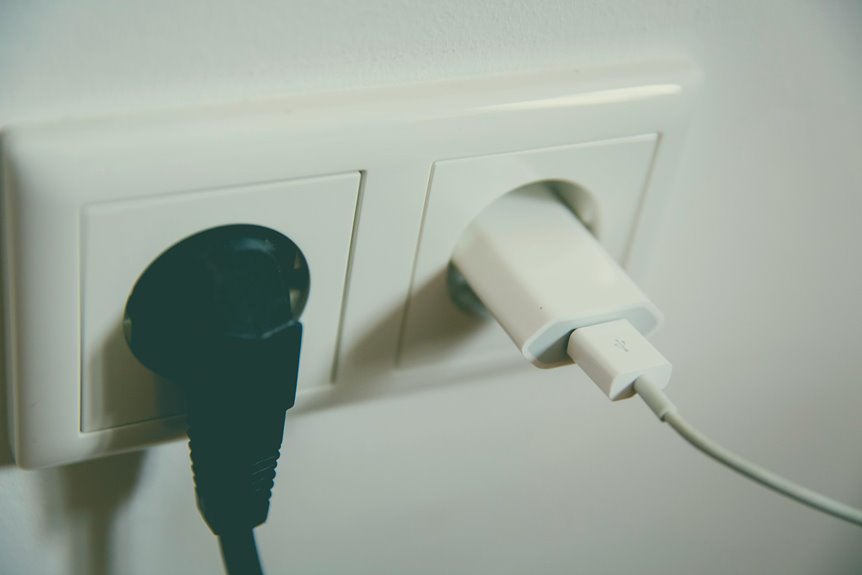When it comes to using power strips and extension cords, safety should be your top priority. You need to understand their wattage and amperage ratings to avoid overloads. It’s also essential to inspect cords for any damage. By following best practices, you can prevent potential hazards. But what are the common mistakes people make that could lead to dangerous situations? Let’s explore that further.
Table of Contents
Key Takeaways
- Always check wattage and amperage ratings to prevent overloading power strips and extension cords.
- Avoid daisy-chaining multiple power strips or extension cords to reduce electrical failure risk.
- Regularly inspect cords for frays, discoloration, or loose connections and replace damaged items immediately.
- Store cords in a cool, dry place and wind them loosely to prevent internal wiring damage.
- Keep cords away from high-traffic areas and never run them under carpets to minimize fire hazards.
Understanding Power Strip and Extension Cord Ratings
When you’re choosing a power strip or extension cord, it’s essential to understand their ratings to confirm safe usage.
Look for the wattage and amperage ratings printed on the device. These numbers indicate how much electrical load the strip or cord can handle. Exceeding these limits can lead to overheating or even fires.
Also, consider the number of outlets available; you don’t want to overload a single outlet. Check for safety certifications, like UL or ETL, which verify the product meets safety standards.
Additionally, pay attention to the cord’s gauge; a lower gauge means it can handle higher currents.
Best Practices for Safe Usage
To guarantee safe use of power strips and extension cords, always position them in a way that allows for proper airflow and prevents overheating.
Here are some best practices you should follow:
- Limit Connections: Don’t plug multiple power strips into one another. This can overload the circuit, increasing fire risk.
- Use Rated Equipment: Ascertain your power strips and extension cords are rated for the devices you’re connecting. This helps prevent overheating and potential damage.
- Inspect Regularly: Check your cords and strips for fraying or damage. If you notice any issues, replace them immediately to maintain safety.
Common Mistakes to Avoid
Many people unknowingly make critical mistakes with power strips and extension cords that can compromise safety. One common mistake is overloading a power strip, which can lead to overheating and potentially cause a fire. You should never plug multiple high-wattage devices into a single strip.
Additionally, don’t daisy-chain extension cords together, as this increases the risk of electrical failure. It’s also a mistake to run cords under carpets or rugs; this can trap heat and damage the insulation.
Moreover, avoid using extension cords as a long-term solution; they’re meant for temporary use only.
Finally, don’t ignore the placement of cords—keep them out of high-traffic areas to prevent tripping hazards. Stay safe by avoiding these pitfalls!
Recognizing Signs of Damage
Overloading power strips and extension cords isn’t the only way to jeopardize safety; recognizing signs of damage is equally important.
You should regularly inspect your devices to verify they’re safe for use. Here are three critical signs of damage to look for:
- Frayed or Exposed Wires: If you see any fraying or exposed internal wiring, it’s time to replace the cord or strip immediately.
- Burn Marks or Discoloration: Any discoloration or burn marks on the surface indicates overheating and potential electrical hazards.
- Loose Connections: If plugs don’t fit snugly in outlets, it can lead to arcing and should be addressed right away.
Stay vigilant, and don’t hesitate to replace damaged cords to keep your space safe.
Tips for Safe Storage and Maintenance
While you might be tempted to toss power strips and extension cords into a drawer, proper storage and maintenance are essential for ensuring their longevity and safety.
Always wind cords loosely and avoid tight coils, which can damage the internal wiring. Store them in a cool, dry place, away from moisture and heat sources.
Label cords and strips to keep track of which ones are in use or need replacing. Regularly inspect them for wear or fraying, and if you notice any damage, don’t hesitate to discard them.
Keep your cords untangled and avoid running them under carpets, as this can create fire hazards. By following these tips, you’ll extend the life of your power strips and extension cords.
Frequently Asked Questions
Can I Use a Power Strip Outdoors?
You can’t generally use a standard power strip outdoors. It’s designed for indoor use and can’t withstand moisture, which could lead to electrical hazards. Instead, look for outdoor-rated extension cords or power strips specifically made for outdoor use.
How Many Devices Can I Safely Connect to One Power Strip?
You can typically connect up to six devices to one power strip, but it’s essential to check the strip’s rating. Avoid overloading it to prevent overheating and potential hazards. Always prioritize safety when using electrical devices.
Are Surge Protectors Better Than Regular Power Strips?
Surge protectors are generally better than regular power strips because they shield your devices from voltage spikes. You’ll enjoy added protection for your electronics, ensuring they last longer and operate safely during electrical fluctuations.
Is It Safe to Daisy-Chain Multiple Extension Cords?
Daisy-chaining multiple extension cords isn’t safe. It can overload the cords and increase fire risks. You should always use a single, appropriately rated extension cord to guarantee your safety and avoid potential hazards.
Can I Use a Power Strip With High-Wattage Appliances?
You shouldn’t use a power strip with high-wattage appliances, as it can overload the strip and pose a fire risk. Instead, plug those appliances directly into a wall outlet for safety and efficiency.


